Sustainable clothing fabrics provide a solution for the environmental problems faced by the fashion industry. By prioritizing materials that are renewable, biodegradable, and produced using eco-friendly processes, we can reduce our ecological footprint and mitigate the harmful effects of fashion industry on our health and planet.
The fashion and textile industry plays a significant role in environmental pollution due to various practices and processes involved in clothing production, from fiber extraction to garment manufacturing and distribution.
Here, we will explore some of the most sustainable clothing fabrics available today, highlighting their environmental benefits, material properties, and growing popularity within the fashion industry.
Table of Contents
Introduction
In today’s fast-fashion world, the fashion industry often runs at the expense of our planet and its resources.
The quest for the latest trends and cheapest deals has increased the popularity of fast fashion, characterized by mass production, low-quality garments, and frequent disposal.
The fashion industry is one of the largest polluters globally, producing huge amount of carbon emissions, water pollution, and textile waste.
From the cultivation of raw materials to the manufacturing process and eventual disposal, each step in the lifecycle of a garment can have a detrimental impact on our planet and its inhabitants.
Textiles are crafted from either natural or synthetic fibers; however, allergic reactions typically come from the chemical treatments applied to these fibers, such as dyes and other finishing chemicals.
Toxic chemicals used in clothing fabrics and their potential health risks are also crucial for empowering consumers to make informed choices about the products they purchase.
What are the common toxic chemicals used in clothing?
There are more than 8,000 chemicals for textile manufacturing process, but it is impractical to discuss here. However, formaldehyde, azo dyes, phthalates, perfluorinated chemicals (PFCs), flame retardants, chlorine bleach, organotin compounds and nonylphenol ethoxylates (NPEs) are commonly used toxic chemical in textile processing.
Toxic chemicals are frequently found as residues in clothing materials even after multiple washing.
Many of these chemicals are carcinogenic in nature or can cause severe health problems, including respiratory diseases and hormonal disruptions.
Clothing fabrics can meet toxic chemicals at any stage, like during the cultivation of fiber, processing of textile, dyeing, finishing, and laundering of fabric.
Unfortunately, all these toxic chemicals can be found in our wardrobes, such as bed linen, outfits, carpets, towels and many more. So, we are exposed to these toxic chemicals daily through our skin by wearing chemically treated clothes. Absorption of these chemicals through skin has been associated with cancer, respiratory problems and contact dermatitis.
In 2018, a Greenpeace investigated remarkable concentrations of toxic and carcinogenic chemicals in several garments they tested.
Additionally, during the textile manufacturing process vast amount of contaminated water is generated, which is often discharged into the water bodies without proper treatment, eventually coming back to our drinking water and food chain, further impacting our health and the environment.
Why toxic chemicals are used in clothing fabrics?
In the textile industry, chemicals are frequently used to increase quality and functionality of fabrics, such as resistance to flames, water, stains, pests and of course to increase durability, softness, color retention of fabrics.
1. Formaldehyde
Purpose: Formaldehyde is a type of Volatile Organic Compound (VOC) and commonly used to prevent wrinkles and improve water resistance and color retention.
Impact on Human Health: Formaldehyde is known as an irritant and allergic substance, which can cause skin rashes, itching, eczema, and respiratory problems.
Prolonged exposure to formaldehyde may increase the risk of asthma and other respiratory conditions. In severe cases, it may also cause cancer.
Some people may experience contact dermatitis or eczema upon contact with this toxic substance. Even small amounts of formaldehyde in clothing can cause skin irritation or allergic reactions.
Therefore, there are strict limits on how much formaldehyde can be used in clothing fabrics.
2. Azo Dyes
Purpose: The main purpose of azo dyes in the textile manufacturing process is to add vibrant colors to fabrics.
Impact on Human Health: Azo dyes are water-soluble and can easily leach from fabrics. Direct contact with these dyes through skin can lead to health issues such as skin irritation, allergic reactions, and cancer in severe cases.
Disperse yellow 3, disperse orange 3, disperse blue 106 and disperse blue 124 are particularly notable for causing contact dermatitis. These dyes are known for their potential skin irritant properties.
In the EU, some azo dyes are banned because of their carcinogenic properties.
3. Phthalates
Purpose: Phthalates are used with rubber and ink to print images and texts on garments.
Impact on Human Health: Phthalates are known endocrine disruptors and have been linked to hormonal disruptions, reproductive issues, and developmental abnormalities.
Upon absorption through skin, these chemicals can interfere with the body’s hormonal balance, potentially leading to reproductive disorders, developmental abnormalities, and hormone-related cancers.
Pregnant women and children are particularly vulnerable to the harmful effects of phthalates found in clothing fabrics, which can disrupt fetal development, leading to birth defects, low birth weight, developmental delays, and reproductive abnormalities.
Due to these concerns, phthalates have been banned in the EU since 2005 and recently in children’s toys in California and Washington State, because children often chew their toys.
It is estimated that phthalates may harm human reproductive system. For instance, three studies conducted between 2000 and 2003 found that exposure to phthalates is associated with reduced semen quality.
Greenpeace tested Disney-themed clothing and discovered that they contained 4% to 10% Bisphenol A by weight. Bisphenol A is dangerous due to its potential health effects on the brain, behavior, and especially on fetuses, infants, and children.
In response to these concerns, the FDA banned Bisphenol A in baby bottles in 2012.
4. Perfluorinated Chemicals (PFCs)
Purpose: PFCs are used to create protective barriers against water and stains, which makes them ideal for outdoor clothing.
Impact on Human Health: PFCs have been associated with various health issues, including cancer, reproductive problems, and liver damage.
They can bio-accumulate in the body organ over time and have serious health issues including organ failure, such as kidney or liver failure.
5. Flame Retardants
Purpose: Flame retardants are used to reduce flammability of clothes, especially in children’s clothes.
Impact on Human Health: Some flame-retardants are known to be toxic and can cause hormone disruption, neurological damage, and developmental delays. They can be released into the air and come in human body through inhalation.
Firefighters, who are heavily exposed to flame-retardants during their work, have been observed to suffer from various health issues, including infertility, neurotoxicity, and cancer.
Additionally, flame-retardants that contain bromine known as brominated flame-retardants (BFRs) have been specifically linked to thyroid and endocrine dysfunction.
These health concerns arise because these chemicals can accumulate in the human body and interfere with hormonal and neurological functions. This is more dangerous for children since they often chew their t-shirt or garments.
6. Heavy Metals
Purpose: Heavy metals are often used in dyeing processes to fix dyes on the fabrics more effectively, resulting in more vibrant and long-lasting colors.
Impact on Human Health: Heavy metals such as lead, mercury, antimony, and cadmium are toxic for humans and can cause neurological damage, organ failure and cancer.
Children often chew their clothes and upon ingestion or absorption through skin, these heavy metals can build up in organs like the liver and kidneys, leading to significant health issues over time.
Lead is a potent neurotoxin that can adversely affect brain development and its function. In children, even low levels of lead can cause cognitive impairments, including reduced IQ, behavioral problems and learning disabilities.
Additionally, lead exposure can also affect physical health, causing slowed growth and development, hearing problems and anemia.
In a similar way, other heavy metals, such as mercury, antimony and cadmium have different types of health issues.
7. Chlorine Bleach
Purpose: It is used to remove unwanted colors from fabric, which brightens and whitens the material.
Impact on Human Health: Chlorine bleach can release harmful fumes that can irritate the skin, eyes, and respiratory track. Prolonged exposure to chlorine bleach is associated with chronic respiratory problems and immune system dysfunction.
Sodium Hypochlorite (NaOCl) and Calcium Hypochlorite [Ca(OCl)2] are mainly used in textile manufacturing process.
8. Nonylphenol Ethoxylates (NPEs)
Purpose: NPEs helps to remove oils, greases, and other impurities from fabrics during the manufacturing process, which can make them suitable for further treatment like dyeing.
They increase water’s penetration into fabrics, which is particularly useful for dyeing and washing processes.
NPEs help to stabilize mixtures of oil and water that normally wouldn’t mix. This property is useful in various chemical treatments applied during the textile manufacturing.
Impact on Human Health: NPEs are endocrine disruptors and can interfere with hormone function upon absorption or ingestion, leading to reproductive issues, developmental abnormalities, and cancer.
However, it is important to note that NPEs are known to break down into nonylphenol (NP), which can cause serious environmental and health concerns. This is the reason why so many countries have banned NPEs.
9. Organotin Compounds
Purpose: They are mainly used to prevent bacterial and fungal growth on textiles and as heat stabilizers during the production of synthetic fibers.
Impact on Human Health: Exposure to these compounds, such as tributyltin (TBT) and triphenyltin (TPT) can disrupt endocrine functions, affecting hormonal systems and metabolism.
Symptoms of organotin toxicity may include neurological damage, immune system suppression and reproductive issues. The severity of health effects often depends on the level and duration of exposure.
Organotin compounds are under strict regulations and in some cases, they are banned, particularly in marine applications due to their long-lasting and toxic nature to aquatic life.
How to avoid the impact of toxic chemicals from clothing fabrics?

Functional Fabrics
Fabrics labeled as wrinkle-free, stain-resistant, waterproof, or flame-retardant typically indicate that they are treated with toxic chemicals to acquire these properties. Simply don’t buy them.
Smell of Chemicals
If clothing has an intense chemical smell, then it is best to avoid. Intense chemical smell is because of high levels of formaldehyde.
Synthetic Fabrics
Synthetic fabrics generally carry more chemical exposure as compared to natural materials. Additionally, they can hamper the detoxification process of the body.
Conventional Cotton
Although cotton is a natural fiber, traditional cotton farming method depends heavily on pesticides, herbicides, and fertilizers. So, it is better to use organic cotton material rather than conventional cotton material since organic cotton uses natural fertilizers, such as animal manure.
Wash Your Cloth after Purchasing
Remember, new doesn’t mean that it’s clean and safe for skin. Wash your cloth before wearing them.
Use Second-Hand Clothing or Sustainable Clothing Fabrics
Many of the chemicals used in clothing manufacture can diminish through washing and regular use. By purchasing second-hand garments, you are likely getting items where these chemicals have already been largely washed out, decreasing the risk of skin irritation and exposure to harmful substances.
Most Sustainable Clothing Fabrics
Sustainable clothing fabrics refers to the textiles that are crafted from raw materials, which are obtained and processed in a manner that minimizes the negative impacts on environment.
These sustainable clothing fabrics reduce waste and pollution, often sourced from recycled or biodegradable materials.
By choosing sustainable clothing fabrics, we can not only look good but also feel-good knowing that we are supporting more responsible and environment friendly practices.
Sustainable clothing fabrics can be made using two types of fibers.
1. Natural Fibers and
2. Synthetic Fibers.
1. Organic Cotton Fabric
Organic cotton is a natural fiber that is grown without the use of synthetic pesticides, herbicides, fertilizers, or genetically modified seeds.
So organic cotton is free from harmful chemicals and residues that can be found in conventional cotton material. This is very useful for those who have an allergy to chemicals.
Organic cotton is often softer and may be less likely to cause skin irritation and allergic reactions, which is making them ideal choice for baby clothing.
Cotton fibers are naturally moisture-wicking, which helps in pulling moisture away from the skin to the exterior of the fabric where it can evaporate, keeping the wearer dry and comfortable.
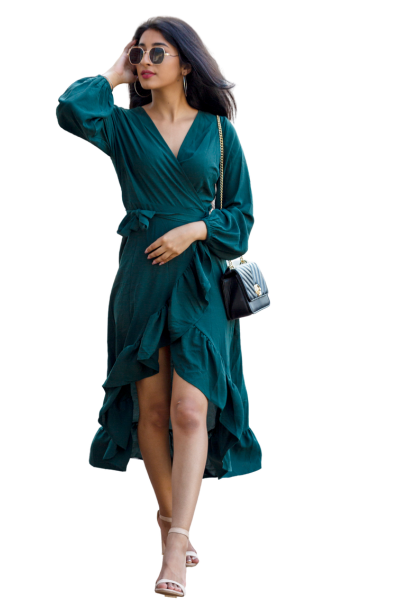
Unlike conventional cotton, which is coated with chemicals, organic cotton is more likely to absorb sweat and reduce the chance of microbial growth. This property makes it particularly suitable for towels, bed linens, and workout clothing, where absorbency is a valued quality.
The difference between organic and non-organic cotton lies in the methods applied during their cultivation and production, particularly in the use of chemicals.
Organic cotton farming method reduces chemical pollution by eliminating the use of synthetic pesticides, herbicides, and fertilizers, which can help to protect aquatic ecosystems, wildlife habitats, and human communities from the adverse effects of chemical contamination.
2. Hemp Fabric
Hemp fabric is made from the fibers of the hemp plant, Cannabis Sativa. Hemp fibers are strong, durable, and naturally resistant to mold and pests, making them ideal for clothing.
Hemp contains compounds known as cannabinoids, including cannabidiol (CBD), which have potential therapeutic benefits when meets skin. These beneficial properties can be retained in hemp fabric even after multiple washing. It becomes increasingly soft with each wash.
Hemp fiber’s porous nature makes it breathable during summer and insulating in winter, ensuring clothes remain comfortable across all seasons.
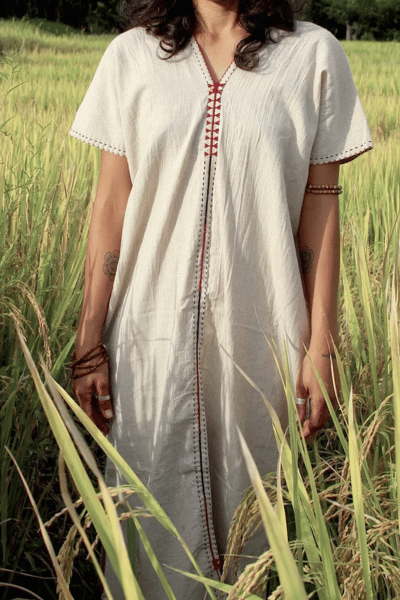
Hemp is hypoallergenic because no chemicals are used in its cultivation and production.
Hemp fibers are one of the strongest and most durable textile fibers. This inherent strength comes into clothing material that is more durable even after many washes.
For instance, hemp T-shirts maintain their shape and durability for many years, unlike most cotton T-shirts, which may start to shrink and deteriorate after a few washes.
Hemp fabric is well known for its usage in towels and bed sheets because of their absorption and durability power.
Production of hemp fabric is not more expensive than cotton fabric. However, the big reason is that cotton is produced in much bigger quantities than hemp, so cotton is cheaper than hemp.
Yes, it’s true that hemp is known for its ability to absorb toxic materials from the environment, including radiation.
In the aftermath of the Fukushima nuclear disaster in Japan, there were discussions and proposals regarding the use of hemp for phytoremediation, which is the process of using plants to remove contaminants from the soil, air, or water.
3. Bamboo Fabric
Bamboo fabric is made from the fibers of the bamboo plant. Known for its softness and breathability, this type of fabric is becoming increasingly popular in the production of sustainable clothing fabrics.
Bamboo fabric possess numerous properties, such as hypoallergenic, antimicrobial, antifungal, UV protection, and moisture-wicking properties.
Bamboo fabric is naturally hypoallergenic, and this is because of its smooth and round structure. Fiber with sharp spurs is the main reason for skin irritation, which is unlikely to be found in bamboo fabric.
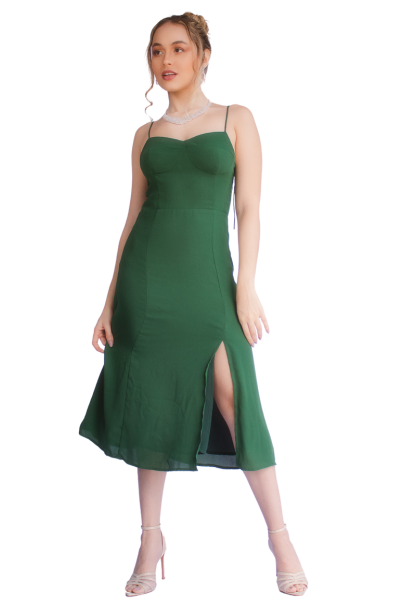
The antibacterial qualities of bamboo fabric can be attributed to an antimicrobial bio-agent called “bamboo kun”, which is found naturally in the fiber. This agent helps to resist the growth of bacteria on bamboo, which in turn reduces the chances of odors, skin irritation, and infections.
Research has shown that bamboo fabric can retain these antibacterial properties even after multiple washes. Its antifungal property in a similar way helps to prevent fungal infection on skin.
Bamboo fibers have micro-gaps and micro-holes, which provide better moisture absorption and ventilation power. This allows bamboo fabric to have superior breathability compared to cotton and other fabrics, which is particularly beneficial in hot and humid conditions.
Studies have suggested that bamboo fabric can cut out over 97.5% of harmful UV rays due to its pectin structure containing bamboo lignin. This UV resistance protects skin from the harmful effects of the sun, making it an excellent choice for outdoor wear.
Like hemp, bamboo fabric is biodegradable and can decompose into a reusable, nutrient-rich compost. This characteristic reduces environmental waste and promotes a more sustainable lifecycle for clothing fabrics.
However, processing bamboo into fabric may involve chemical and mechanical treatments, so it’s essential to choose eco-friendly production methods.
Consumers looking to maximize their sustainable impact should seek out bamboo clothing made from mechanically processed bamboo or labeled as using eco-friendly methods.
4. Tencel (Lyocell) Fabric
Tencel is a brand name of Lyocell, which is developed by the Austrian company Lenzing AG. It is a sustainable clothing fabric made from wood pulp of eucalyptus trees.
Tencel fabric has a silky-smooth texture and luxurious feel, making it incredibly soft and comfortable to wear. It drapes beautifully and has a gentle touch against the skin, making it ideal for sensitive individuals.
It has good moisture-wicking properties, which helps to keep the wearer dry and comfortable, particularly important in hot and humid conditions.
Bacteria prefers to grow in moist conditions. But because of the excellent moisture wicking property of Tencel, bacteria are less likely to grow. Making them ideal for activewear, sportswear and undergarments.
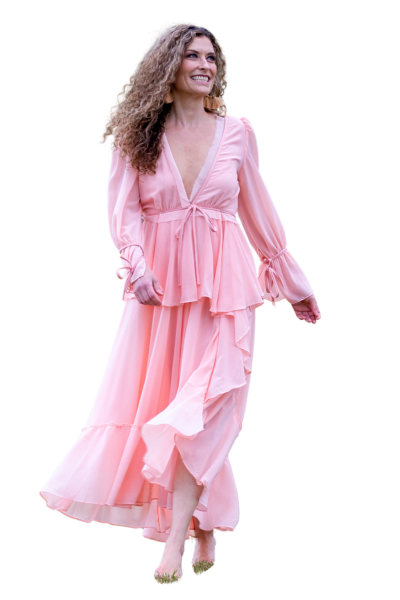
Tencel fibers have a smooth surface and recover well from wrinkling, which reduces the need for ironing. However, its shrinkage ratio is like cotton, but can absorb moisture more than cotton.
Unlike cotton, Tencel can hold color and appearance for many years.
5. Organic Linen Fabric
Organic linen, derived from the fibers of the flax plant (Linum Usitatissimum), represents a sustainable and eco-friendly option in the world of textiles.
The stalks of the hemp plant are used to make linen fabric, while the seeds are utilized as a food source, and the oil extracted from the seeds is known as linseed oil.
Its cultivation and processing are less harmful to the environment as compared to other natural textile fibers like conventional cotton.
Linen absorbs up to 20% of its weight in water without feeling moist. Its rapid absorption and carrying of moisture help to keep your skin dry and clean throughout the day and night.
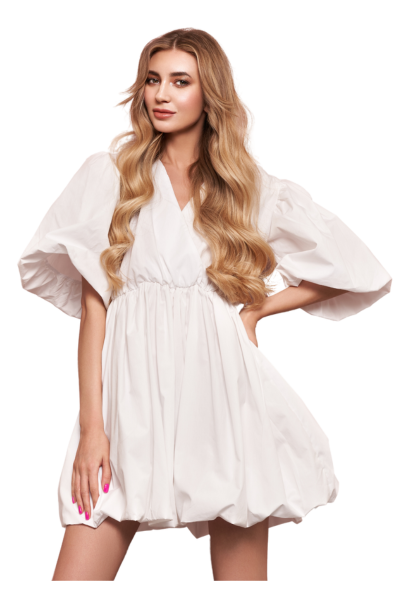
Clothing made from organic linen is durable, lightweight, comfortable, biodegradable, breathable, hypoallergenic, and naturally antimicrobial, which is making them the best sustainable choice for consumers.
Its cellulose fibers are longer and tighter, which makes them three times stronger than cotton.
Even after multiple washes, its shape and color remain intact for many years. So linen is the most preferred textile material for bed sheets. However, it is also used in a wide range of products, including clothing, aprons, bags, towels (for swimming, bath, beach, body, and wash), napkins, runners, and upholstery.
It’s commonly used in sailcloth, sewing threads, handkerchiefs, tablecloths, sheets, collars, cuffs, and more.
6. Recycled Wool Fabric
Recycled wool is a sustainable textile material made from discarded wool cloths, textile manufacturing waste or post-consumer wool waste that is collected, sorted based on their color and texture, and then processed to create new wool fibers.
Recycled wool diverts textile waste from landfills, incinerators, and other disposal sites, helping to reduce pollution and environmental harm by minimizing the need for new raw materials and energy-intensive processing.
Recycled wool retains the natural properties and warmth of virgin wool while promoting resource efficiency and waste reduction.
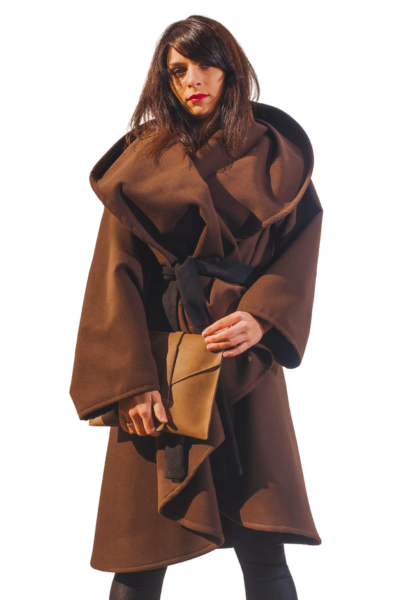
Wool has natural antimicrobial properties that inhibit the growth of odor-causing bacteria, keeping garments fresh and odor-free even after prolonged use.
Wool fibers are highly absorbent and can absorb water up to 30% of their weight without feeling wet.
Recycled wool also exhibits a high level of flame resistance and doesn’t release toxic chemicals when burned.
Wool fiber is hygroscopic, meaning it attracts moisture. This property allows wool to draw moisture away from the body and absorb it into the fiber. As moisture is absorbed, heat is generated, keeping the garment warm without feeling damp or clammy.
Wool is well-known for its excellent thermal regulation properties, which makes them a popular choice for thermal wear, such as socks and sweaters and have an impressively long lifespan, often being passed down from one generation to the next generation.
Wool fibers are naturally elastic, which means garments made from recycled wool can stretch, but return to their original shape upon release.
The outer scales of wool fibers create a barrier that makes it tough for dirt and dust to get through. Instead of soaking in, stains tend to stay on the surface of the fibers, making wool naturally resistant to stains. This feature also makes it easier to clean compared to many other types of fibers.
Wool is naturally resistant to fire. It doesn’t catch fire easily and tends to smolder rather than bursting into flames. Unlike synthetic fibers, wool doesn’t melt and stick to your skin, which makes it a great choice for blankets, carpets, and even uniforms for firefighters.
7. Modal Fabric
Modal fabric is a type of HWM rayon, typically made from the cellulose of beech trees. Modal fabric is categorized as semi-synthetic as it is made from both organic and synthetic material.
It is known for its softness, high tensile strength, and high level of breathability, which make it an increasingly popular choice in clothing, bedding and other textile products.
Modal is highly breathable and moisture-absorbent, allowing it to wick moisture away from the skin and keep the wearer cool and dry. It provides comfort and ventilation, making it suitable for active wear, loungewear, and undergarments.
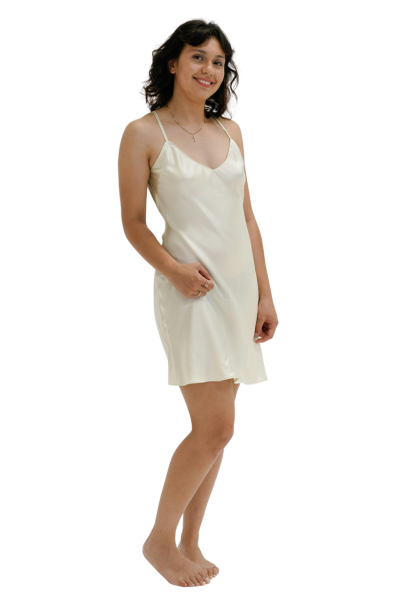
Modal has excellent color retention properties, allowing it to retain vibrant colors even after multiple washes. It resists fading and bleeding, ensuring that garments and textiles maintain their original appearance and aesthetic appeal.
Modal rayon is often used as the best alternative to silk or cotton. It is also known as “artificial silk” and popular for scarves and nightwear.
Modal fabric is biodegradable and compostable, meaning it can break down naturally in the environment without leaving behind harmful residues or microplastics.
8. Alpaca Wool Fabric
Alpaca wool fabric derived from the fleece of the alpaca, a native South American camelid, is highly known in the textile industry for its unique and superior qualities compared to other fibers like sheep’s wool.
Alpaca wool is renowned for its softness and luxurious feel against the skin. It is often compared to cashmere and merino wool in terms of its fine texture and comfort, making it a premium choice for clothing and textiles.
It has excellent thermal properties due to its microscopic air pockets, trapping heat close to the body in cold weather without the feeling of bulkiness, unlike other wool fibers. These air pockets also enhance breathability in warmer climates, preventing the wearer from overheating.
Unlike sheep’s wool, alpaca wool does not contain lanolin, a natural grease found in some animal fibers that can cause allergic reactions in sensitive individuals. This makes alpaca wool hypoallergenic and suitable for wearers who are prone to allergies or skin irritation.
Additionally, it can absorb moisture vapor from the body without feeling wet, making it excellent for regulating body temperature and keeping the wearer dry and comfortable.
Alpaca fibers are incredibly strong, surpassing the tensile strength of sheep’s wool. Furthermore, alpaca fibers have a high degree of elasticity, allowing clothing to maintain its shape and resist tearing.
Alpaca wool is naturally flame-resistant and provides excellent UV protection, which protects the skin from harmful ultraviolet rays more effectively than many other fabrics.
9. Peace Silk (Ahimsa Silk) - Queen of Fabrics
Peace silk is produced using a cruelty-free process that allows silkworms to complete their life cycle and emerge as moths.
Traditional silk production involves boiling silkworms alive to extract their silk fibers, which raises ethical concerns about animal welfare.
In contrast, peace silk is made from the cocoons of silkworms that have been allowed to complete their natural life cycle and emerge as moths.
Peace silk fabric has a luxurious texture, which feels smooth against the skin. It is often used to create high-quality clothing, scarves, and other luxury textile products.
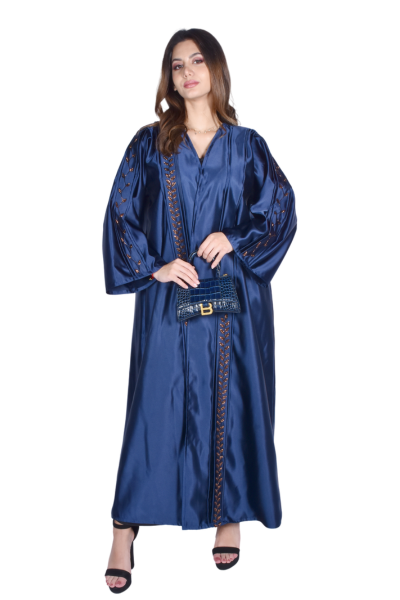
Peace silk is hypoallergenic and gentle on the skin, making it suitable for individuals with sensitive skin or allergies.
Peace Silk retains the same desirable qualities as conventional silk, including high breathability and moisture absorbency. This makes it exceptionally comfortable to wear, particularly in warm climates, as it helps regulate body temperature by allowing air circulation and wicking moisture away from the skin.
Silk is known for its tensile strength, and Peace Silk is no exception. It is a durable material that resists tears and abrasions, making it suitable for long-lasting clothing items. Its natural elasticity also helps garments maintain their shape and reduce wrinkling.
Like conventional silk, Peace Silk is a natural fiber that is fully biodegradable.
10. Cork Fabric
Cork fabric also known as cork leather, is a natural plant-based material derived from the bark of the cork oak tree (Quercus Suber), predominantly grown in mediterranean regions.
As a plant-based material, cork is an excellent alternative to animal-derived materials like leather, which is offered as a cruelty-free option for consumers looking for sustainable fashion.
This material is gaining popularity in the fashion industry due to its unique characteristics and environmental benefits.
Cork fabric is hypoallergenic and resistant to mold, mildew, and bacteria growth, making it suitable for individuals with sensitive skin or allergies. It does not trap dust, allergens, or odors, reducing the risk of skin irritation and allergic reactions.
Cork fabric is naturally water-resistant and moisture-repellent due to its waxy layer called corkiness on its cells, making it suitable for use in products that may be exposed to water or humidity, such as bags, wallets, and footwear.
Cork fabric gives remarkable stain resistance or stain can be removed by simple washing with water and soap, unlike other clothing materials.
Despite its softness, cork fabric is highly durable and resilient, able to withstand everyday wear and tear without losing its shape or integrity. It is lightweight, making it ideal for travel accessories and everyday use.
Cork fabric is biodegradable and compostable, meaning it can break down naturally in the environment without leaving behind harmful residues or microplastics.
11. Soy Silk Fabric
Soy silk fabric also known as “soybean protein fiber” or “soy fiber”, which is made from the residue of soybeans called tofu or soybean oil production.
Soy silk helps to reduce waste by utilizing the byproducts of soybean processing that would otherwise be discarded or underutilized.
By repurposing soybean residue into textile fibers, soy silk contributes to waste reduction efforts and promotes a circular economy model.
Soy silk is often compared to silk in terms of its feel and texture, offering a smooth, soft finish that is comfortable against the skin. This makes it particularly suitable for clothing that requires a soft touch, such as underwear, sportswear, and baby clothing.
This innovative textile is part of a growing trend toward using bio-based materials in fashion, while promoting sustainability and the efficient use of resources.
12. Kapok Fabric
Kapok fabric is derived from the fibers of the seed pods of the kapok tree, a tropical tree also known as Ceiba Pentandra. This tree is native to Mexico, Central America, the Caribbean, and parts of South America, as well as West Africa and parts of Asia.
Kapok fiber is hypoallergenic and resistant to mold, mildew, and dust mites, making it suitable for individuals with allergies or respiratory sensitivities. It does not trap allergens or irritants.
Kapok fiber is highly breathable and has natural moisture-wicking properties, allowing air to circulate freely and regulate body temperature. It helps to keep the body cool and dry, making it ideal for bedding and sleepwear.
Kapok fibers are among the lightest natural fibers in the world. They are hollow and have a very low density, which makes fabric extremely lightweight and buoyant. This property makes kapok garments exceptionally comfortable to wear, especially in warm climates.
Kapok fibers are coated with a waxy substance that repels water. This natural water resistance makes kapok fabric suitable for outerwear and other applications where moisture resistance is advantageous.
Kapok forests absorb more carbon and play a crucial role in mitigating climate change by absorbing and storing carbon dioxide from the atmosphere.
As a natural vegetable fiber, kapok is fully biodegradable. This characteristic makes it environmentally friendly at the end of its lifecycle, contributing to reduced landfill waste.
13. Nettle Fabric
Nettle fabric, particularly made from the fibers of the stinging nettle plant (Urtica Dioica), offers a range of intriguing properties that make it a sustainable choice for clothing fabrics.
Nettle fibers are naturally strong and durable, making them suitable for producing robust sustainable clothing fabrics that withstand wear and tear. This strength is comparable to hemp and could be superior to cotton, which makes nettle fabric ideal for outerwear and workwear.
Nettle fiber is highly breathable and moisture-wicking, allowing air to circulate freely and helping to regulate body temperature. It absorbs moisture away from the skin, keeping the wearer cool and dry in warm weather.
Nettle fabric has good insulation properties, keeping the wearer warm in cold weather while remaining breathable. This is due to the hollow structure of the nettle fibers, which trap air and provide natural thermal regulation.
Research indicates that nettle fibers possess natural antibacterial properties, making them beneficial for hygiene in clothing by inhibiting the growth of bacteria. This characteristic is particularly valuable in sportswear or garments that are subjected to frequent sweating.
14. Jute Fabric
Jute fabric which is derived from the fibers of the jute plant, primarily Corchorus Olitorius and Corchorus Capsularis.
Jute fabric is known for its strength, durability, and breathability, making it perfect for crafting sustainable clothing fabrics suited for warm climates. Its breathable nature allows for comfortable wear by promoting air circulation and managing moisture effectively.
Unlike many synthetic fibers, jute has antistatic property. This means it does not generate static charge nor cling uncomfortably to the body.
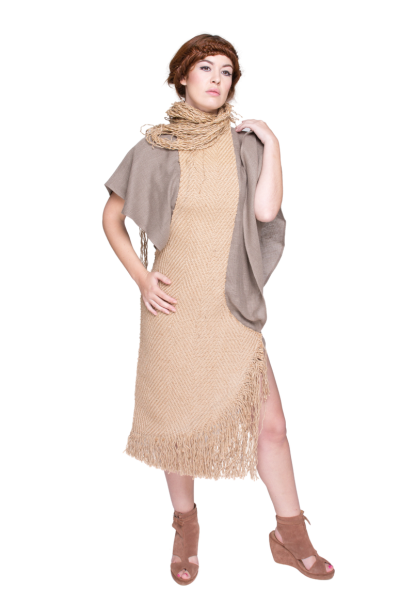
While jute is still more commonly associated with industrial and home textiles due to its coarse texture, its use in clothing is expanding, particularly in the eco-fashion industry where its sustainability credentials are highly valued.
Innovations in textile processing are increasingly making it possible to create softer, more wearable forms of jute that are suitable for everyday clothing as well as fashion items.
15. Sisal Fabric
Sisal fabric is made from the fibers of the Agave sisalana plant, a species of agave native to southern Mexico, but widely cultivated in many countries with arid environments (less than 10 inches of rain per year).
Traditionally it is used for rope, twine, and various other products due to its high strength and durability, sisal is also utilized in the textile industry for specific types of apparel and accessories.
Clothing made from sisal offers a robustness that can withstand wear and tear, making it ideal for outerwear and workwear that require high resistance to stress and abrasion.
Sisal fabric absorbs moisture well, which can help in keeping the body dry and comfortable in warm conditions. The fabric also promotes air circulation, which is crucial in hot and humid climates.
Sisal fibers are naturally anti-static, meaning they do not retain static electricity. Additionally, sisal has inherent fire-retardant properties, making it safer for use in environments where there is a risk of fire.
Though sisal is not as widely used in mainstream clothing due to its coarseness and rigidity compared to softer textiles like cotton or silk, its application in fashion is typically seen in items where its unique texture and durability are advantageous, such as hats, bags, shoes, and decorative trim on garments.
16. Recycled Polyester Fabric
Recycled polyester is made from waste plastic bottles (PET) or other recycled polyester materials. It reduces dependence on virgin petroleum-based materials and helps to divert plastic waste from landfills or oceans.
Recycled polyester retains the same durability, strength, and performance characteristics as virgin polyester while reducing environmental impact and promoting resource efficiency.
It is produced by breaking down used polyester products into their original polymer form, which is then spun into new fibers for textile production.
It is resistant to wrinkles, stretching, shrinking, and fading, making it suitable for a wide range of clothing and textile applications.
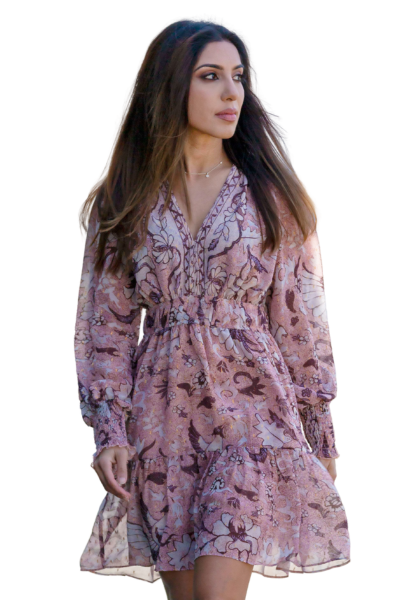
Low Impact Textile Materials
Recycled polyester significantly reduces the environmental footprint associated with fabric production. Firstly, it helps in diverting plastic waste from landfills and the environment, reducing soil and water pollution as well as harmful effects on wildlife.
Secondly, compared to virgin polyester, recycled polyester requires less energy to produce (up to 59% less energy according to some studies) and helps to reduce carbon emissions.
The majority of recycled polyester used in clothing nowadays comes from repurposed plastic bottles rather than recycled clothing. Shockingly, the average American discards around 40kg of clothes and shoes each year, but only a small fraction is actually recycled.
17. Econyl Fabric
Econyl serves as a sustainable substitute for traditional nylon, deriving from discarded nylon sources like abandoned fishing nets, fabric remnants, and industrial plastic waste.
Econyl represents a trademark owned by Aquafil, an Italian plastics company.
It helps to clean marine environments and reduces the demand for new nylon production.
Clothing made from Econyl fabric has a soft and smooth texture that feels gentle against the skin. It’s lightweight, breathable, water-resistant, and quick in drying properties, making it ideal for swimwear and activewear.
Econyl fabrics offer high resistance to chlorine, sun creams, and oils, making them particularly useful for swimwear and active sportswear.
Econyl also maintain their color and shape well over time, even under tough conditions, which is crucial for both consumer satisfaction and environmental impact.
18. Pinatex Fabric
Pinatex is an innovative textile made from pineapple leaf, which is a byproduct of the pineapple harvest. It is developed by the company Ananas Anam, which offers a cruelty-free and eco-friendly alternative to conventional leather.
Pinatex makes use of agricultural byproducts that would otherwise be discarded or incinerated. By utilizing this agricultural waste, Pinatex helps to reduce waste and promote resource efficiency.
Being a natural plant-based material, Pinatex is largely biodegradable. This quality ensures that it has a lower environmental impact at the end of its lifecycle compared to synthetic materials, contributing to reduced landfill waste.
19. Coir Fabric
Coir fiber, derived from the fibrous husk of the coconut. It is traditionally used in products, such as mats, brushes, and ropes due to its rough texture and durability.
While not commonly used in mainstream clothing due to its coarse nature.
Coir fibers are naturally tough and wear resistant. They have high tensile strength and abrasion resistance, which makes them suitable for producing durable clothing items, particularly where ruggedness is required, such as in workwear or protective garments.
Coir has a naturally high lignin content (a complex organic polymer in plant cell walls) which makes it resistant to rotting and moisture. This property is beneficial to design clothing for humid or wet environments.
The natural composition of coir includes bio-compounds that resist microbial growth and prevent the accumulation of odors. This characteristic can be particularly beneficial in developing activewear or clothing intended for prolonged use without washing.
Coir is a natural by-product of coconut production and the use of coir in textiles supports sustainability because it utilizes a waste product from the coconut industry and is biodegradable, reducing environmental impact.
Despite these benefits, the roughness and rigidity of coir make it less suitable for sustainable clothing fabrics, especially those requiring direct contact with skin.
However, advancements in textile processing and blending coir with other softer fibers (like cotton or bamboo) have led to newer fabrics that capitalize on the benefits of coir while improving comfort and wearability.
These innovations expand the use of coir in the fashion industry, particularly in eco-conscious segments that value durability, sustainability, and unique textile properties.
Coir coconut fiber is ideal for crafting nets used in harvesting fish and ropes for marine tasks because it remains unaffected by seawater, ensuring durability and reliability in marine applications.
20. Corn Starch Fabric
Corn fabric, often known as PLA (polylactic acid) fiber, is a biopolymer made from fermented plant sugar derived from corn starch and other crops.
As an alternative to petroleum-based fibers like polyester, corn fabric offers several beneficial properties that make it an appealing choice for eco-friendly textiles manufacturers.
One of the most compelling reasons for using corn fabric is its biodegradability in industrial composting facilities.
Unlike traditional synthetic fibers, which can take hundreds of years to decompose and release microplastics, PLA can break down into natural elements under the right conditions, significantly reducing environmental pollution.
Each season, between 5 to 10% of corn ends up as waste in silos. However, this agricultural waste serves as valuable material for transformation. Cargill Dow Polymers LLC pioneered the development of corn fiber, also known as Ingeo Fiber, utilizing this surplus corn to create a new and innovative material.
Corn starch fabric comes in both spun and thread forms, offering lighter and stronger materials. From knitwear to sportswear, footwear to outer garments, corn starch fabric is the best sustainable material.
Corn starch fabric offers a multitude of benefits:
– Hypoallergenic and gentle on sensitive skin.
– Anti-wrinkle, perfect for travel wear.
– Free from chemical additives or treatments.
– Naturally flame retardant and compostable.
– Maintains strength, color, and properties over time better than synthetics.
– Stain resistant and superior UV resistance compared to synthetics.
– Provides enhanced breathability compared to polyester.
21. Seaweed Fabric
Seaweed fabric, often integrated into textiles either by being blended with other natural fibers or through processes that transform seaweed itself into usable fiber, is becoming an increasingly popular choice in the textile industry due to its unique and beneficial properties.
Vitamins, minerals, amino acids, and antioxidants are found in seaweed. When processed into fabric, these beneficial compounds can be retained to some extent in resulting fabric and provide potential skin benefits such as hydration, promoting cell regeneration, and having anti-inflammatory properties.
Seaweed contains antioxidants that interact with free radicals in the skin, effectively neutralizing them. This process not only reduces environmental damage to the skin but also helps slow down the aging process.
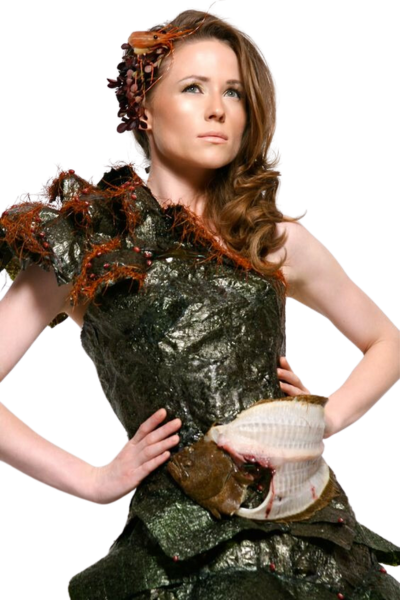
These characteristics make seaweed fabric particularly appealing for undergarments, sportswear, and clothing that directly comes on skin.
Seaweed naturally contains antibacterial and antifungal agents for getting survive in its marine environment. These properties can be advantageous when transferred to textiles, as they help to prevent microbial growth.
Seaweed fabric can absorb moisture more than cotton, which can keep you dry and comfortable by managing sweat well.
22. Milk Protein Fabric

Milk fiber, also known as milk protein fiber or casein fiber, is a regenerated protein fiber derived from milk. Cow milk contains 80% casein protein.
Milk that is unsuitable for human consumption doesn’t go to waste—it’s repurposed to create innovative fibers known as milk fiber or casein fiber.
In Germany alone, a staggering 1-2 million tonnes of milk are discarded annually. This highlights the massive scale of global milk waste. To address this issue, QMilch GmbH, a German company, has developed milk fiber as a sustainable clothing material.
Milk fiber contains 18 amino acids, which are beneficial for the skin, however the effectiveness of these amino acids from fabric can vary.
Production of milk fiber involves extracting casein protein from surplus milk that cannot be consumed, thereby utilizing a by-product of the dairy industry that might otherwise be wasted.
Milk fiber is gentle on the skin and hypoallergenic. This makes it suitable for people with sensitive skin or allergies to synthetic fibers or other natural fibers like wool.
Milk fiber is known for its soft, silky texture, comparable to silk or very finely spun wool. This softness provides exceptional comfort and makes it suitable for direct-skin-contact clothing such as lingerie, t-shirts, and babywear.
Research has shown that milk fiber has inherent antibacterial properties. These properties help in reducing the growth of bacteria, which can cause odor and deterioration of the fabric.
Milk fiber is highly absorbent, capable of wicking moisture away from the body, which helps in keeping the wearer dry and comfortable. This characteristic is particularly valued in active wear and in climates with high humidity.
Milk fiber is an excellent choice for undergarments, sportswear, and baby clothing.
23. Coffee Grounds Fabric
Coffee grounds fabric is an innovative material made by integrating recycled coffee grounds into yarns, which are then woven into sustainable fabrics. This material leverages the unique properties of coffee, turning a waste product into a valuable clothing.
Coffee grounds naturally absorb odors due to their porous structure, which can trap and neutralize smells. This makes coffee ground fabric particularly suitable for sportswear and active wear, as it can help to reduce odors caused by sweating.
Coffee ground contains numerous compounds, including melanoidins, which can absorb ultraviolet (UV) rays. Therefore, it offers a degree of UV protection to protect the skin from harmful solar radiation.

Coffee ground fabric is known for its fast-drying capabilities. The micro-pores in the coffee grounds enhance the fabric’s ability to disperse moisture more efficiently than conventional fabrics, leading to quicker drying times.
Using coffee ground to create fabric also promotes a circular economy by utilizing waste products from the coffee industry.
Each year, tons of coffee grounds are discarded, often ending up in landfills where they can create potent greenhouse gas, called methane.
Repurposing these coffee grounds into sustainable clothing fabric reduces waste and the environmental footprint of both the coffee and textile industries.
When coffee grounds are thrown into landfills, they release methane, a greenhouse gas that’s 30 times more potent than carbon dioxide (CO2), contributing to environmental harm.
To mitigate environmental issues, two harmful products, coffee waste and plastic water bottles, must be repurposed for sustainable clothing materials.
How can we choose sustainable clothing fabric?
When selecting sustainable clothing fabrics, it’s essential to consider various factors to ensure their sustainability, such as certification, process transparency, material composition, energy efficiency, water usage and biodegradability.
As more people want eco-friendly products these days, there’s been a big increase in “green products” on the market. But, unfortunately, some companies aren’t honest about how green their products really are. They use tricky green washing tactics to make themselves seem eco-friendly even if they’re not.
Greenwashing is a misleading marketing technique adopted by companies to present their products as environmentally friendly, often to increase their sustainability credentials.
Certifications play a crucial role in protecting the consumer and the environment from green washing tactics. There are several standards and certifications for sustainable clothing fabrics. Some of these include:
OEKO-TEX Standard 100
The OEKO-TEX Standard 100 is a globally recognized certification system for sustainable textiles materials.
It ensures that textiles are free from harmful chemicals and will not pose any significant risk to human health.
It involves comprehensive testing of a wide range of chemicals that are used in clothing manufacturing.
OEKO-TEX Standard 100 sets strict limits on harmful chemicals that are allowed in textile manufacturing by ensuring their high safety standards.
OEKO-TEX Standard 100 certification provides assurance to consumers that the textiles they are purchasing have been thoroughly tested and verified for their safety. Consumers should check OEKO-TEX label before purchasing.
Textile manufacturers and brand owners often seek OEKO-TEX certification to demonstrate their commitment for producing safe and environment friendly products.
Global Organic Textile Standard
The Global Organic Textile Standard (GOTS) is the leading worldwide standard for organic clothing materials.
By establishing comprehensive criteria that covers the entire supply chain, from the sourcing of raw materials to the final product labelling, GOTS provides authentic assurance for sustainable materials.
This standard not only promotes environmental sustainability but also encourages ethical and socially responsible manufacturing practices.
Ultimately, GOTS certification empowers consumers to make informed choices, fostering a more sustainable and transparent textile industry.
Some key aspects of GOTS include:
1. Organic Fiber Content: GOTS requires that a product should contain at least 95% certified organic fibers.
2. Environmental Criteria: GOTS prohibits the use of toxic chemicals and dyes during processing and manufacturing.
3. Social Criteria: GOTS ensures fair labor practices throughout the supply chain, including safe working conditions and fair wages for workers.
4. Traceability and Labeling: GOTS requires strict documentation and traceability of organic fibers from the raw material stage to the finished product.
Cradle to Cradle Certified
Cradle to Cradle Certified is a globally recognized standard for certifying products based on their environmental and social performance throughout their entire life cycle.
It evaluates products across five key categories:
1. Material Health: Evaluating the safety and environmental impact of materials that are used in textile products.
2. Material Reutilization: Evaluating the material potential for recycling or composting.
3. Renewable Energy and Carbon Management: Promoting the use of renewable energy sources and strategies to reduce carbon footprint during textile production.
4. Water Stewardship: Evaluating water usage and management practices to minimize water consumption and prevent pollution.
5. Social Fairness: Ensuring fair labor practices, ethical sourcing, and social responsibility throughout the product’s life cycle.
The certification provides consumers with assurance that the product has been rigorously evaluated and meets high standards for environmental sustainability, material health, and social responsibility.
Bluesign Standard
The Bluesign Standard is a comprehensive system for managing environmental and occupational health and safety concerns in the textile industry.
It was developed with the goal of minimizing the environmental impact of textile production while simultaneously ensuring a high level of consumer safety.
Bluesign evaluates and addresses various aspects of textile production, including:
1. Input Stream Management: Bluesign evaluates the chemicals, materials, and processes used in textile production.
2. Resource Productivity: The standard encourages the efficient use of energy, water, and raw materials throughout the manufacturing process, reducing waste and environmental impact.
3. Air Emissions: Bluesign sets strict criteria for controlling and reducing air emissions from textile manufacturing facilities.
4. Water Emissions: The standard aims to minimize water usage and prevent water pollution by implementing advanced wastewater treatment technologies.
5. Worker Health and Safety: Bluesign considers occupational health and safety practices, ensuring that workers in textile production facilities are protected from exposure to hazardous chemical and working conditions.
6. Consumer Safety: Bluesign evaluates the finished textile products to ensure that they meet stringent safety standards, minimizing the risk of harmful substances being present in the final product and ensuring consumer health and safety.
Fair Trade Certified
Fair Trade Certified is a designation given to products that meet certain social, economic, and environmental standards set by Fair Trade organizations.
The Fair Trade movement aims to promote better trading conditions and empower producers in developing countries by ensuring fair wages, safe working conditions, and sustainable practices.
Some key principles of Fair Trade certification include:
1. Fair Prices: Fair Trade ensures that producers receive fair prices for their products, providing them with a stable income and enabling them to invest in their businesses and communities.
2. Fair Labor Practices: Fair Trade certification requires producers to adhere to labor standards that protect workers’ rights, including safe working conditions, freedom of association, and prohibitions against child labor and discrimination.
3. Community Development: Fair Trade organizations support community development initiatives, such as education, healthcare, and infrastructure projects, to improve the well-being of producers and their families.
4. Environmental Sustainability: Fair Trade promotes environmentally sustainable practices, such as organic farming, agroforestry, and water conservation, to minimize the environmental impact of production and protect natural resources.
5. Transparency and Accountability: Fair Trade organizations promote transparency and accountability in the supply chain, providing consumers with information about the origin of products and the impact of their purchases.
Global Recycled Standard (GRS)
The Global Recycled Standard (GRS) is an international, voluntary standard that sets requirements for the certification of products made with recycled content.
It was developed by the Textile Exchange, a global nonprofit organization that promotes sustainability in the textile industry.
The GRS establishes criteria for the verification of recycled materials, as well as for social, environmental, and chemical practices throughout the supply chain.
Key aspects of the GRS include:
1. Recycled Material Content: The GRS requires products to contain a minimum percentage of recycled material. This can include both pre-consumer waste and post-consumer waste.
2. Traceability and Chain of Custody: The standard mandates traceability systems to track the recycled material from its source through to the final product, ensuring transparency and accountability in the supply chain.
3. Environmental Criteria: The GRS sets requirements for environmental management, including energy and water use, chemical use and restrictions, and waste management practices, to minimize the environmental impact of production processes.
4. Social Criteria: The GRS includes provisions for social responsibility, such as fair labor practices, safe working conditions, and compliance with relevant labor laws and regulations.
5. Chemical Restrictions: The standard restricts the use of certain hazardous chemicals in accordance with international regulations for protecting workers, consumers, and the environment from harmful exposure.
Conclusion
By choosing sustainable clothing fabrics, we are not only protecting the environment, but also safeguarding our health and the well-being of future generations.
Throughout this exploration of sustainable clothing fabrics, from organic cotton to innovative fibers like milk fabric and Pinatex leather, we have uncovered both style and sustainability.
Clothing fabrics that are produced with eco-friendly processes, free from harmful chemicals, and sourced from renewable materials can significantly reduce the environmental impact.
Let’s continue to promote sustainable clothing fabrics not only for their environmental benefits but also for their role in protecting our health and the health of future generations.

I’ve spent over three hours online today, but I haven’t found any article as interesting as yours. I believe it’s truly valuable. If all website owners and bloggers produced content like yours, the internet would be more beneficial than ever.